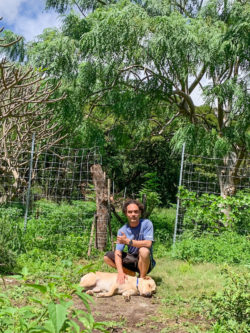Local Farmer Launches Chicken Feed Experiment
By Paul Hanley, Community Reporter

Photo by Paul Hanley.
Molokai is experiencing a population explosion—of laying hens. Sust’ainable Molokai’s Poultry Egg Education Project (PEEP) has already helped 35 Molokai ‘ohana get into egg production, for their own use and for sale through the Mobile Market.
While this is a significant gain for local food self-reliance, Molokai producers are still dependent on imported chicken feed. To be truly self-sufficient, the feed will have to be produced here as well, and Molokai farmer Ehiku Arnold may have a solution. He has launched an experiment to see if laying hens can survive and thrive on feed he produces on his farm.
At first glance, Arnold’s fenced, 1800-square-foot chicken yard in Kamalo looks like an overgrown patch of weeds. Close inspection reveals a carefully thought-out grazing pen with multiple sources of food for the hens.
A lifelong Molokai resident, Arnold’s interest in food production and security started when he was in high school. His parents used to take him along to visit friends who were farmers, and he began to take an interest in different crops and growing methods. Soon he was digging up the lawn and planting vegetables to help feed his family.
One of the plants he grew was gandule bean, better known as pigeon peas. The perennial legume is one of many species now growing in his chicken pen to provide a protein source for the hens.
“Over a 10-year period, through careful selection, I developed my own gandule cultivar that produces pods faster and is much easier to shell than conventional types. Now if I dry the pods on a black tarp, when they heat up in the sun, they pop open,” said Arnold.
This year he was able to process 100 pounds of peas, which are also good for human consumption.
Arnold’s approach to raising chickens gives “free-range” a whole new meaning. In addition to gandule, he has introduced a prolific local variety of lima bean to the pen. Other food sources include casava, sissoo and Chinese spinach and moringa, a good source of calcium. Plants such as lemon grass, native basil, rosemary, and plantain are part of the mix to provide a nutrient rich diet, with medicinal benefits.
“I have included hot Hawaiian chile peppers, which should help control intestinal parasites,” said Arnold. “Compost piles and snags of branches and logs are positioned here and there to create favorable environments for all kinds of bugs, which are highly nutritious for chickens.”
In a couple of old bathtubs, Arnold is growing nutritious duckweed and azolla, a fast-growing water plant that is rich in protein, vitamins, and minerals. Additional feed sources will include coconuts and, potentially, Malabar chestnuts.
“I have 60 chicks ordered for April delivery,” said Arnold. “I expect to produce at least seventy percent of the feed for my chickens, but I’ll use some commercial feed at first as the chicks are growing.”
The design of the chicken pen itself is ingenious.
“It involves a radial rotation system,” explains Arnold. “The chicken coop in the center will have multiple doors opening onto seven subdivided sections of the bigger pen. Every day I’ll let the chickens out into a different section of the pen. That way, each section will have a full week to recover and regrow after intensive one-day grazing.”
Arnold’s goal is to help Molokai to be truly food self-reliant and to promote “restorative farming.”
“We never know when the food might stop arriving from the mainland. We can produce our own food but also use restorative farming methods that rejuvenate the land and make it more productive.”
To further this goal, Arnold formed Paa’aina LLC in 2020.
“Paa’aina means ‘hold tight to the land.’ The aim is to stop erosion, improve soil fertility, and bring back native species, while growing food at the same time,” he says.
Arnold has already held workshops on soil improvement using microbial fermentation, based on Korean Natural Farming methods. This approach helps build soil fertility with no-to-low cost on-farm inputs.











Don't have a Molokai Dispatch ID?
Sign up is easy. Sign up now
You must login to post a comment.
Lost Password